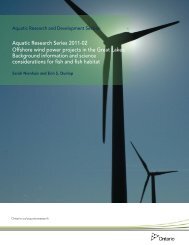Ontario's Natural Heritage Areas - Ministry of Natural Resources
Ontario's Natural Heritage Areas - Ministry of Natural Resources
Ontario's Natural Heritage Areas - Ministry of Natural Resources
Create successful ePaper yourself
Turn your PDF publications into a flip-book with our unique Google optimized e-Paper software.
Selection Criteria<br />
Candidate areas can be nominated by private<br />
citizens and staff from the Canadian Wildlife Service,<br />
other government agencies, and non-government<br />
organizations. Usually, the Canadian Wildlife Service<br />
completes inventories, mapping, and assessments<br />
<strong>of</strong> the habitat <strong>of</strong> a nominated area. To qualify for<br />
consideration as a Migratory Bird Sanctuary, an area<br />
must meet one <strong>of</strong> the following criteria:<br />
• The area supports concentrated populations,<br />
for any part <strong>of</strong> the year, in order to meet one or<br />
many essential needs, and which are vulnerable<br />
to site-specific threats.<br />
• The area supports populations that occupy<br />
habitats <strong>of</strong> restricted geographical area and are<br />
threatened by human disturbance.<br />
• The area regularly supports at least 1% <strong>of</strong> a<br />
population <strong>of</strong> one species or subspecies.<br />
• The area is crucial in the requirement for<br />
the management <strong>of</strong> regional populations<br />
<strong>of</strong> migratory birds and/or highly qualifies<br />
as an educational or interpretative resource<br />
(Environment Canada, 2005a).<br />
An area selected as a Migratory Bird Sanctuary<br />
requires the consent <strong>of</strong> the landowner (e.g., other<br />
federal departments, the provincial/territorial<br />
government, or private landowners) or title to the<br />
land. Once designated as a Migratory Bird Sanctuary,<br />
the site is ‘scheduled’ under the Migratory Birds<br />
Convention Act sanctuary regulations (CWS and CWF,<br />
2003).<br />
Management Objectives and/or Guidelines<br />
Migratory Bird Sanctuaries protect migratory birds<br />
against physical disturbance and hunting (CWS<br />
and CWF, 2003). With the exception <strong>of</strong> active nests,<br />
sanctuaries do not protect habitat. The status <strong>of</strong><br />
Migratory Bird Sanctuaries is contingent upon<br />
landowner consent and retention <strong>of</strong> the high value <strong>of</strong><br />
the site for protecting migratory birds. Regulations<br />
under the Migratory Birds Convention Act protect<br />
migratory birds from:<br />
• Hunting. For example, the regulations forbid<br />
a person to carry a firearm in a Migratory Bird<br />
Sanctuary or to trap any migratory bird.<br />
• Egg harvesting.<br />
• Removal <strong>of</strong> nests.<br />
• Pets. Pets are prohibited from running at large<br />
(CWS and CWF, 2003; Mosquin et al., 1995; Ward<br />
and Killham, 1987).<br />
The regulations only control activities within Migratory<br />
Bird Sanctuary boundaries when migratory birds are<br />
present. Management includes periodic inspection,<br />
enforcement <strong>of</strong> hunting prohibitions and regulations,<br />
and maintenance <strong>of</strong> signs. In some cases, the CWS<br />
prohibits visitors during critical periods (e.g., nesting<br />
and molting). In some Migratory Bird Sanctuaries,<br />
habitat has been enhanced, and in others research<br />
is conducted on the birds. Most Migratory Bird<br />
Sanctuaries are not staffed and do not have on-site<br />
visitor services (CWS, 1994).<br />
The Degree <strong>of</strong> Protection for Migratory Bird<br />
Sanctuaries and the Corresponding IUCN<br />
Protected Area Management Category:<br />
A Preliminary Assessment<br />
Some Migratory Bird Sanctuaries qualify as ‘partially<br />
protected’ areas because although protection is the<br />
primary objective and the commitment is legislated,<br />
they are not protected year-round in perpetuity and<br />
they do not necessarily exclude industrial activities<br />
and large-scale developments. In other cases,<br />
Migratory Bird Sanctuaries are ‘fully protected’<br />
because they are located in regulated designations<br />
such as National Wildlife <strong>Areas</strong>. These regulated<br />
areas may qualify as IUCN Category Ia, II, III or IV<br />
protected areas, depending upon the degree <strong>of</strong> legal<br />
or formal protection <strong>of</strong>fered.<br />
Key Contact(s)<br />
Canadian Wildlife Service<br />
Environment Canada<br />
P.O. Box 490<br />
Lambeth Station<br />
London, Ontario<br />
N6P 1R1<br />
Phone: 519-472-6695<br />
Website: www.hww.ca/hww2.asp?cid=4&id=231#sid78<br />
Information: EnviroInfo.Ontario@ec.gc.ca<br />
133 Ontario’s <strong>Natural</strong> <strong>Heritage</strong> <strong>Areas</strong>

















